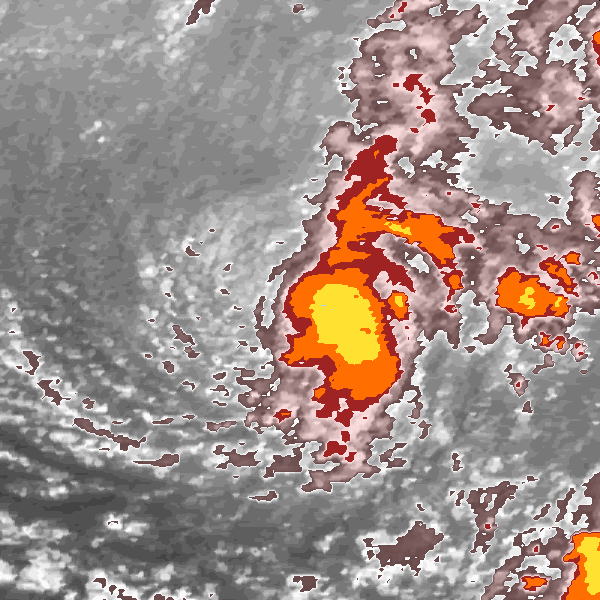Subject: ACC0004kun
Comments
-
 by
bretarn
translator
by
bretarn
translator
I'm not very confident with my classification as #shear!
Posted
-
 by
bretarn
translator
by
bretarn
translator
When you look at storm page , you can see it's evolution from shear to eye. Following image of these 6 shaped as first tutorial image as eye
Posted
-
 by
Struck
moderator, translator
by
Struck
moderator, translator
Hi bretarn, a good task for us as civil scientist to find the solution for your question. I think,a clear classification is difficult here.
Posted
-
 by
Struck
moderator, translator
by
Struck
moderator, translator
Personally I would always use the notes about shear-storm from the 'Help-Page' from the category 'Shear'.
Posted
-
 by
Struck
moderator, translator
by
Struck
moderator, translator
A shear-storm should have:
a)Center of gray swirl is closer to the colored clouds
b)The cold area has a tight swirl itself and is organizedPosted
-
 by
Struck
moderator, translator
by
Struck
moderator, translator
So I create a wind-route pic for possible wind routes for this storm:

Posted
-
 by
Struck
moderator, translator
by
Struck
moderator, translator
In the W we can see a white/gray #swirl, which an #anti-clockwise wind-route. The center of grey swirl is in the NW of the storm-center.
Posted
-
 by
Struck
moderator, translator
by
Struck
moderator, translator
But one feature makes me think about our shear theory, because of aspect a) of the argumentation for shear-storms. Personally I can not see,
Posted
-
 by
Struck
moderator, translator
by
Struck
moderator, translator
that the center of the swirl is closer to colored clouds or the distance between every coloured area is not very small, beginning from NW.
Posted
-
 by
Struck
moderator, translator
by
Struck
moderator, translator
Maybe possible could be an #embedded-center, but what do you and other civil scientist think about this storm-image. Great pic, bretarn. = )
Posted
-
 by
shocko61
by
shocko61
Hi Struck ,Hi bretarn ,I would give it one more shot at Embedded when I first had this type of formation I would go with shear but after
Posted
-
 by
shocko61
by
shocko61
a few times like that ,I found that the storm would redevelop into embedded and some times into an eye, so I like now to have shear storms
Posted
-
 by
shocko61
by
shocko61
with at least a close margin to the edge of the pink-gray and gray swirl showing that there is a cold front taking the warmer air away .Ian
Posted
-
 by
bretarn
translator
by
bretarn
translator
Thanks for your analysis , helps me a lot to have better understanding, roughly it was my way of thinking
Posted
-
 by
bretarn
translator
by
bretarn
translator
but my english language need some improvement to tell it properly. these kind of images, sitting between shear and embedded
Posted
-
 by
bretarn
translator
by
bretarn
translator
gives quite a challenge to be classified . Jean-Maurice
Posted
-
 by
cch001
scientist
by
cch001
scientist
I would go #shear here. By the way, tropical cyclones do not have cold or warm fronts. They exist in nearly uniform air masses
Posted
-
 by
shocko61
by
shocko61
Hi cch001, Hi bretarn , Hi Struck, a good day to you all , My mistake cchoo1 , I thought that to shear the storm was deadened by a cold
Posted
-
 by
shocko61
by
shocko61
front , as the weather bureau sometimes says the cyclone has lost intensity due to a clod front ?? Please set me right . ???
Posted
-
 by
bretarn
translator
by
bretarn
translator
I read article in french edition of Scientific American, explaining how cyclones are fueld by warm sea waters,
Posted
-
 by
bretarn
translator
by
bretarn
translator
and loose their strength passing over colder waters or simply when they land and consequently energy fueled by warm water is lost.
Posted
-
 by
shocko61
by
shocko61
Hi bretarn , thank you very much ,it is cold and warm water not air . Ian shocko61
Posted
-
 by
cch001
scientist
by
cch001
scientist
Shear is just winds going different directions or speeds at different heights. A TC can develop a cold front, but when it does it is no
Posted
-
 by
cch001
scientist
by
cch001
scientist
longer a TC by definition - it is post- or extra-tropical
Posted
-
 by
shocko61
by
shocko61
Hi cch001 , Thank you for the information I will remember that .Ah I see the light . Ian shocko61 :=)
Posted
